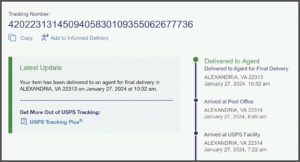The urgent question outstanding for those who file utility patent applications at the USPTO is, are they stuck with no choice but to pay the $400 penalty to preserve the safe and trusted legacy PDF filing path, or is there any chance that the “DOCX with auxiliary PDF” path might present an acceptable level of professional liability risk so that the client could avoid the $400 penalty? Maybe the USPTO will clarify this.
The “DOCX with auxiliary PDF” filing path was established through a set of five Federal Register notices (blog article). Regrettably the FR notices are unclear about the extent to which a patent owner that had selected the “DOCX with auxiliary PDF” path, upon detecting some USPTO mistake in the issued patent due to DOCX rendering, would be assured of being able to get the USPTO mistake corrected.
When does the USPTO cut off possible corrections in its DOCX rendering? A first category of lack of clarity in the FR notices is whether the window for correction of a DOCX rendering mistake expires a year after the patent application was filed. Would the hint in the June 6, 2023 FR notice of “an ongoing safeguard” from the auxiliary PDF file actually provide a reliable correction mechanism for the life of the issued patent? Or would the one-year-from-the-application-filing date limit in the June 2, 2021 FR notice control?
Applicants should not expect to have a request to correct the electronic record granted if the request is based on the source or evidentiary copy and it is filed more than one year after submission of the [patent application].
What correction mechanism is available? A second category of lack of clarity in the FR notices is the nature of the corrective mechanism, if any, that is available during the life of the issued patent. If correction of USPTO DOCX rendering mistakes based on the auxiliary PDF is indeed available for the life of the patent, is the correction mechanism the trusted and familiar “Certificate of Correction” mechanism, or is it the untrusted “petition” mechanism? The FR notices make it sound as though the only correction mechanism would be a petition, and it is unclear what excuses the USPTO might seize upon for an arbitrary dismissal of such a petition. In particular one wonders whether the USPTO, in deciding to dismiss such a petition, might rely upon nit-picking of real or imagined failure of the auxiliary PDF file to supposedly match the DOCX file that had been uploaded by the filer? The only acceptable answer would be that the patent owner can rely on the two-decades-old trusted and familiar Certificate of Correction path. A simple visual comparison is made of the issued patent and the auxiliary PDF file, and if they fail to match, then the USPTO would be required to issue a CofC adopting the content of the auxiliary PDF file. But the FR notices do not clearly give this sole acceptable answer.

Given the fuzziness of the five FR notices on these topics, I wrote a letter to the person (a Mark Polutta) named in the five FR notices as the person to contact with questions. (You can see a PDF of the signed letter here.) I emailed it to him on January 24, 2024. I also sent it by trackable mail on that day. The USPTO received the letter on January 27, 2024 (see tracking at right).
As of February 6, there had been thirteen days of silence from the USPTO on this. So I phoned up Mr. Polutta. I reached his voice mail and I left a message. Yesterday, February 7, Mr. Polutta returned my call. He says that I will receive an answer to this letter.
If and when the answer arrives, my plan is to post it here.

Isn’t there some legislated requirement that PTO fees be directly related to the cost of providing whatever service a user is getting for his money?
I’m wondering why an applicant has to cough up $400 to file a document that’s **already in the format the PTO wants it to be in.** What does that $400 buy, exactly?
From the outset, the USPTO has claimed that its cost to do the OCR is $3.15. So one would figure that the fee to avoid the cost of the OCR ought to be related in some rational way to the $3.15 amount.
Does Sec. 10(h) of the AIA, 125 Stat. 284, 319, eliminate the fees-must-be-related-to-cost requirement, at least as to that specific fee?